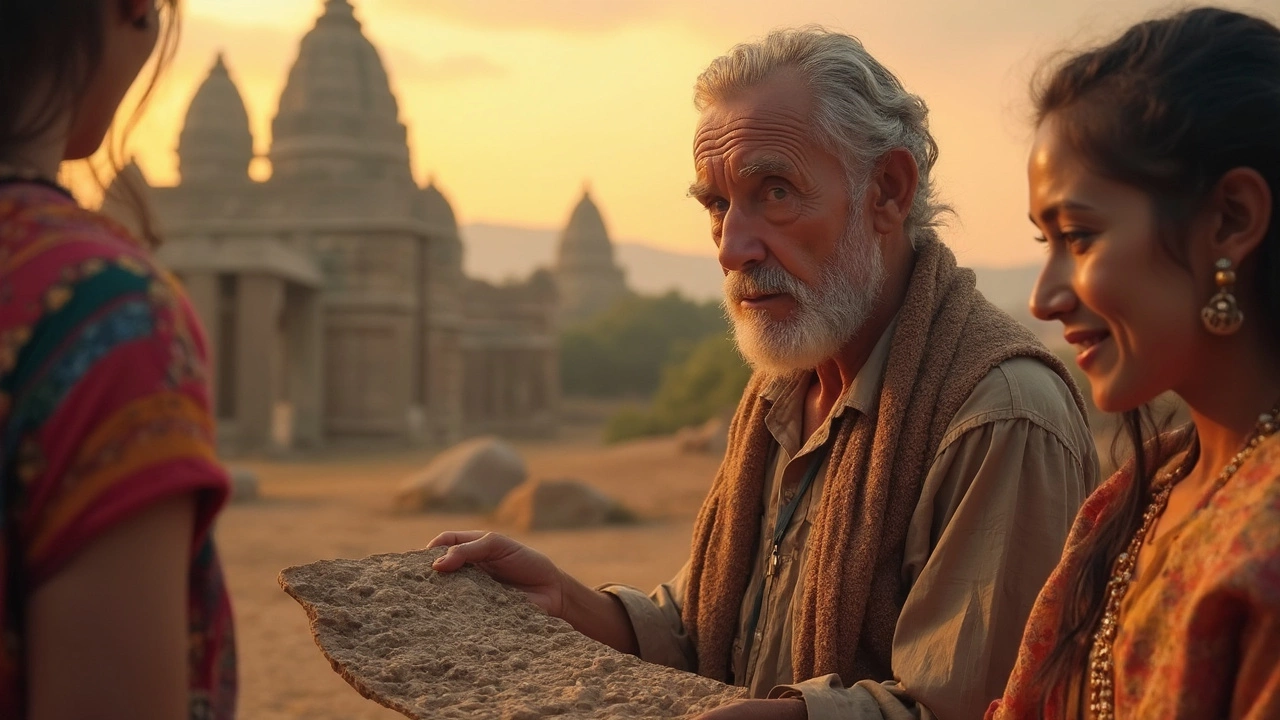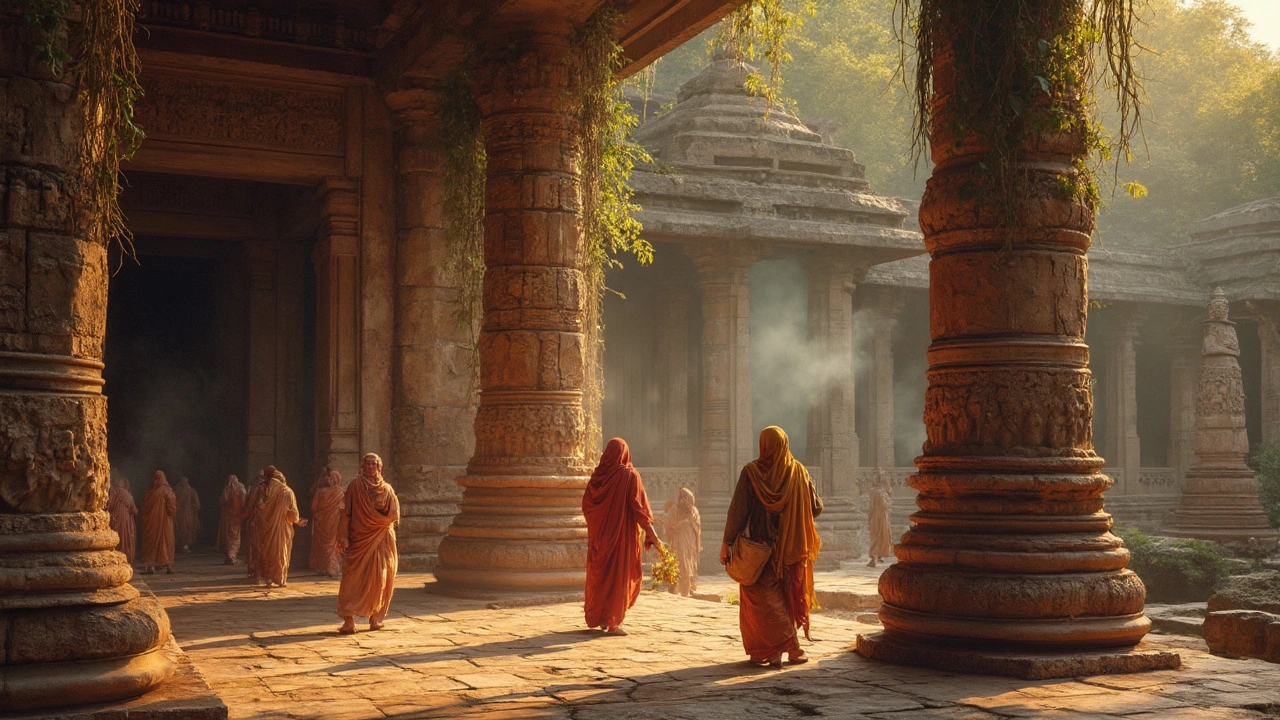People love a good legend, but when it comes to 5000-year-old temples in India, the facts aren’t as clear-cut as the stories promise. Temples like Dwarka and Somnath come up in every ancient temple conversation, but there's a lot more to the story than just numbers or myth. If you’re searching for a true slice of ancient India, it helps to know what’s real, what’s folklore, and what you can actually visit in 2025.
Tons of travel sites toss around the idea of 5000-year-old temples, but most of what you’ll see today were rebuilt, sometimes several times over. Earthquakes, invasions, and time itself forced people to reconstruct their sacred spots. Still, many of these places have roots—or at least stories—tracing back to ancient civilizations.
When planning a temple tour, it’s smart to check which temples have archaeological evidence backing their age and which ones rely mostly on legends passed through generations. That doesn’t make them any less impressive, but it can help set the right expectations before you pack your bags. You’ll avoid the tourist trap of chasing a temple that’s all talk and no stones left from its original days.
- The Truth About 5000-Year-Old Temples
- Dwarka and Its Ancient Legends
- Exploring Somnath: Myths and Realities
- Tips for Visiting Ancient Temples in India
The Truth About 5000-Year-Old Temples
Let’s clear up the buzz around India having a 5000 year old temple. The problem is, a lot of claims don’t hold up when you actually look at the physical evidence. Many temple legends say they were built thousands of years ago, but those stories often mix facts with local lore or epic tales like the Mahabharata. When archaeologists dig in, they rarely find structures or stones that are 5000 years old and still part of today’s temples.
Take Dwarka, for example—some people say Lord Krishna’s city and temple were built over 5000 years ago. But the Dwarkadhish Temple standing now only goes back to around the 15th century CE, even though underwater ruins nearby suggest there was something much older. Those ruins haven’t been proven as a continuous place of worship dating that far back.
If you look at Somnath, the “eternal shrine,” you’ll hear it’s been around since the time of the gods. Reality check: this temple’s been destroyed and rebuilt several times, with the current structure finished in 1951. Sure, the spot has a long history, but the building itself isn’t ancient stones from 5000 years ago.
Let’s be real: the oldest surviving temple complex with firm proof is probably the Mundeshwari Temple in Bihar, which dates to the 4th century CE. That’s ancient, but nowhere near 5000 years old. Even places like Konark Sun Temple or Kailasa Temple in Ellora aren’t close to five millennia.
So, what’s the takeaway? If you care about authentic history, check if a temple’s age is backed by hard evidence, like carbon dating or inscriptions—not just stories or online hype. Ancient doesn’t always mean original, and India’s real magic is how these sites have adapted and survived, not just how old they are.
Dwarka and Its Ancient Legends
When people talk about a 5000 year old temple in India, most point straight to Dwarka. This city shows up in old Hindu texts as the legendary kingdom of Krishna, with claims that it was built about five millennia ago. Sounds epic, right? But here’s what’s really going on.
Archaeologists have actually found underwater structures off Dwarka’s coast that hint at ancient settlements. The National Institute of Oceanography has dated some of these remains to between 3,000 and 1,500 BCE. That doesn’t mean the current Dwarkadhish Temple was built then—today’s temple pops up in history way later, with most of the structure being rebuilt in the 16th century after storms and attacks trashed the old one.
The truth is, the Dwarkadhish Temple we see now has seen a lot of action. It’s been flattened by natural disasters, rebuilt by rulers (most notably by the great Aditya Simha in the 15th-16th centuries), and kept alive by locals. The belief that this spot carries 5,000 years of history links more to Krishna’s mythology than to any stone-by-stone timeline.
- If you’re traveling to Dwarka expecting an untouched ancient site, don’t. You’ll find a bustling temple with a deep spiritual vibe and a coastal town that’s loud with stories more than stones from 3,000 BCE.
- Guided tours sometimes take you to spots where underwater exploration is ongoing. Ask your guide; some let you peek into the science behind the myths.
- Visiting during the Janmashtami festival (usually August) is wild—thousands pack the temple, and there’s a non-stop celebration of Krishna’s birthday.
If you like your history with hard facts, here’s a look at the Dwarka timeline, ancient finds, and temple history:
| Event/Period | Date (Approx.) | What Happened |
|---|---|---|
| Earliest settlement traces offshore | 3000-1500 BCE | Remnants found underwater; not confirmed as city temples |
| Temple first referenced in records | 8th century CE | Potentially first major stone temples built here |
| Reconstruction after destruction | 15th-16th century CE | Aditya Simha and others restored and expanded the temple |
| Current structure maintained | Modern era | Repairs, additions, and festival upkeep |
So, Dwarka is loaded with legend, and there’s no denying the place gives you goosebumps. But if you’re hunting for actual 5000-year-old temple stones, you’ll be mixing a bit of fact with a lot of faith here.

Exploring Somnath: Myths and Realities
Whenever people talk about ancient temples in India, Somnath almost always comes up. The legend says it’s been standing on the Gujarat coast for around 5000 years, and some folks even believe it was built by the Moon god himself. But here’s what you really need to know: the current structure was finished in 1951. That’s not a typo—the physical stones you’ll see today aren’t even a hundred years old.
Of course, age isn’t just about rocks and bricks. The Somnath site itself has been mentioned in old texts—including the Skanda Purana and the Mahabharata—which is why people call it one of the oldest and most important pilgrimage spots. But over the centuries, Somnath temple was raided and rebuilt so many times that almost nothing of the original remains. Some historians count at least six major destructions and reconstructions.
“The present Somnath temple is the seventh structure built on the original site, which carries immense historical and spiritual significance but not the original 5000-year-old stones.” — Archaeological Survey of India report, 2017
Here’s a quick breakdown of some key moments in Somnath’s wild history:
- First mentioned in texts probably over 2000 years ago.
- Mahmud of Ghazni famously destroyed the structure in 1026 CE.
- It was rebuilt several times between the 11th and 18th century.
- The most recent temple was rebuilt and opened in 1951.
If you’re checking it out, the cool part is soaking in the stories, the waves crashing nearby, and the feeling that you’re standing where millions have worshipped and worried and hoped for thousands of years.
| Fact | Details |
|---|---|
| Location | Prabhas Patan, Gujarat, India |
| Current Structure Completed | 1951 CE |
| Original Temple Referenced | Texts dated before 400 BCE |
| Number of Rebuilds | At least 6 major times |
Bottom line? While the Somnath temple’s ancient temples reputation is tied to powerful legends, the structure you’ll walk through is actually pretty new. Still, if you care about spiritual power, epic history, or dramatic stories, this spot hits all the right notes.
Tips for Visiting Ancient Temples in India
Heading to India’s ancient temples is more than snapping a quick pic—it’s about experiencing a piece of history for yourself. Don’t just look for the oldest signboard or the loudest guide; there’s a better way to make the most of your trip.
- Plan Early and Double-Check Timings: Many ancient temples have strict entry times and get crowded quickly, especially during regional festivals. Check the official temple site or reliable travel forums for opening hours and peak days.
- Respect Dress Codes and Shoe Rules: Most old temples require shoulders and knees to be covered, and shoes must come off at the entrance. Carry a pair of socks if you’re not keen on going barefoot.
- Go with a Local Guide: The colorful legends are amazing, but only a good guide can point out which stories are fact and which are clever folklore. Ask for guides approved by state tourism boards—they usually know their stuff.
- Photography Rules Change Fast: Some places allow photos outside but not inside the sanctum. Watch for posted signs or just ask attendants so you don’t get yelled at or fined.
- Carry Cash for Donations and Purchases: Even in 2025, smaller temple towns may not accept digital payments everywhere. A little cash goes a long way for donations or snacks.
If you’re traveling far—like to Dwarka or Somnath—book a stay nearby. Dropping in for a day trip means you miss the real buzz of morning and evening rituals. These moments feel different from the daytime tourist rush.
| Temple Name | Location | Claimed Age | Original Ruins Visible? |
|---|---|---|---|
| Dwarka Temple | Gujarat | Up to 5000 years (legend) | No (Current construction ~16th century) |
| Somnath Temple | Gujarat | First built ~2000 BC (claimed) | No (Many reconstructions) |
| Madurai Meenakshi | Tamil Nadu | Oldest parts ~7th century AD | Some |
If you care about diving deep into the history and culture, grab a quick read of the story behind the temple before you go. But remember, even if you’re chasing that 5000 year old temple India dream, what’s still standing is usually younger—yet the atmosphere is just as powerful.
